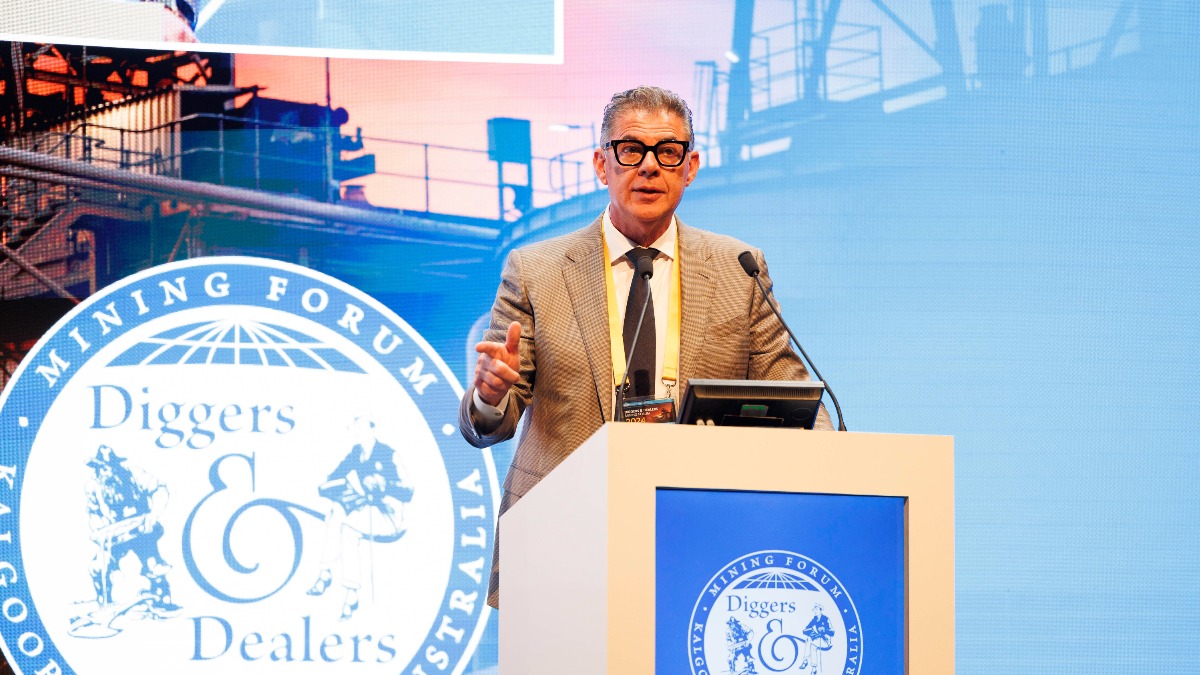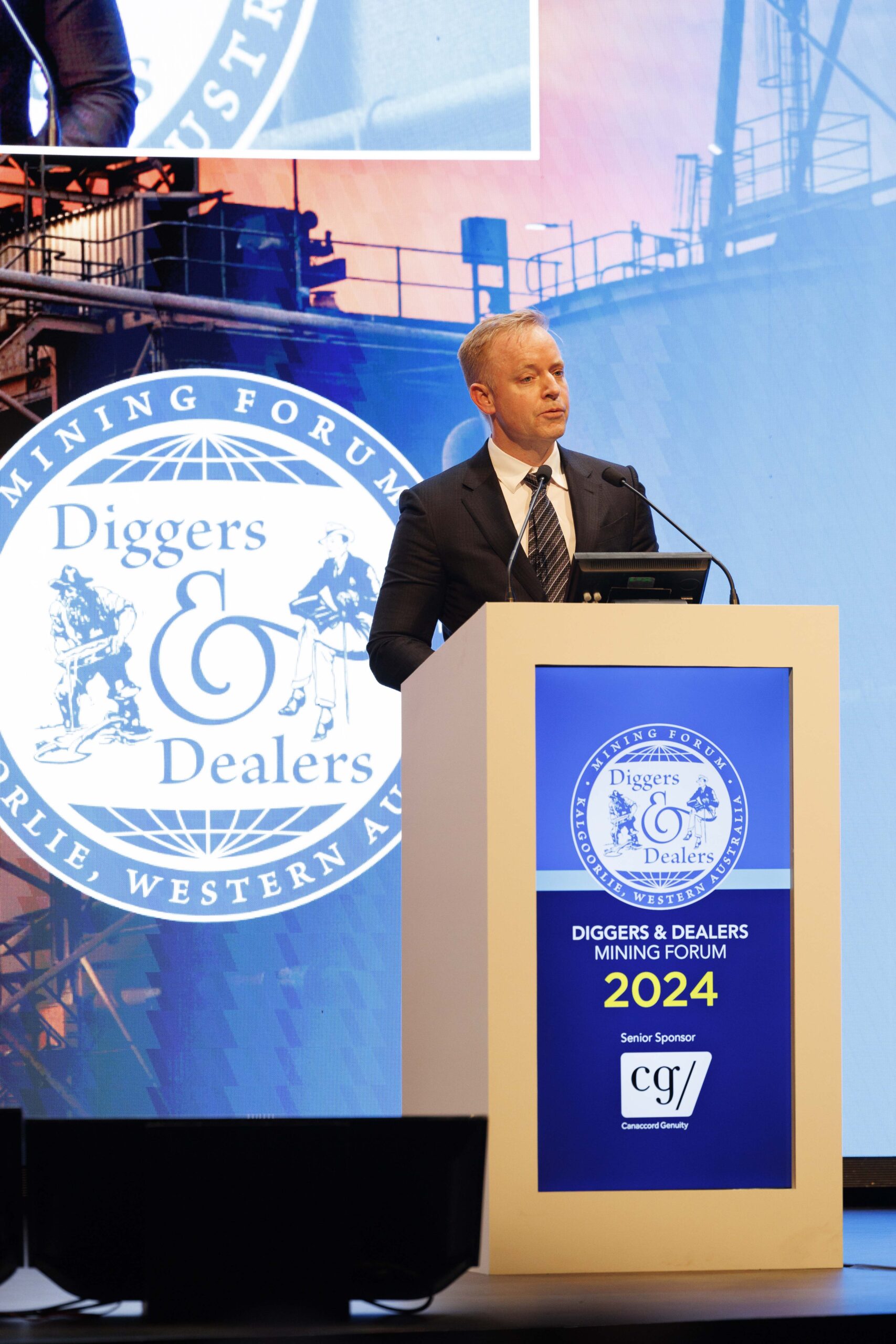Diggers and Dealers: Lithium refineries on the edge?

Liontown Resources' Tony Ottaviano. Pic: Diggers and Dealers
- Albemarle slows investment in Aussie lithium refinery
- Raises questions over future of downstream chemical processing for EV batteries in Australia
- Market participants still see value in going up the value chain despite teething issues
The lithium sector copped another hit on the eve of Diggers as America’s Albemarle punted plans to expand its underperforming Kemerton refinery, pausing what appears to be over a billion buckaroos of investment.
It’s the latest blow for downstream processing in Australia, making a virtual mockery of production tax credits announced by the federal government in May for introduction in 2027, with hollowed-out prices just one reason for the decision.
Albemarle also suggested the ownership of the Greenbushes mine (over 25% of which is held by China’s Tianqi) meant the material it produces at Kemerton is not garnering IRA compliance from the very China-sensitive US.
Then there are production issues, with the first 25,000tpa train of the plant, where the final three trains have now been suspended, still to ramp up and in the process of qualifying product with customers.
It mirrors issues IGO (ASX:IGO) and Tianqi have had ramping up their loss-making Kwinana lithium hydroxide plant.
The fading promise of Australia’s downstream lithium refineries has been a sideshow to broader issues for the lithium market in 2024. Outside of South Korea and Japan, the major hard rock producer is the only location looking to break China’s stranglehold on lithium chemical production, a key cog in the electric vehicle supply chain.
IGO managing director Ivan Vella remains confident that Australia can build the capability as long as multiple plants and their adjacent supply chains can get up and running.
“There’s 60 of those plants across China. So there’s just a huge scale advantage, a cluster of capability. And I think then their workforce as well are really quite skilled, whereas we’re quite new to it,” he told media at Diggers and Dealers in Kalgoorlie.
“Kwinana has been there for a little while, it is building up and Covalent (SQM and Wesfarmers) next cab off the rank. But collectively, that’s only three.
“So it’s tough, and there’s no question that it would be great seeing that industry start to have some success and some progress, and I’m sure that would also build some more momentum inside the industry around suppliers and just general capability that helps us be successful.”
Liontown looks downstream
At current prices, Vella said margins remain low, a point driven home by Albemarle’s decision.
Chemicals prices are in the low teens, giving less leeway to companies that underperform expectations. Spodumene prices, the main lithium chemical feedstock, have fallen from US$8000/t in 2022 to US$890/t.
“The margins are very low, and there’s a lot of stress on the industry. But I just finished talking about how much growth is coming, and that demand supply balance not being smooth, so it’s very difficult to look forward with a crystal ball and see how it plays out,” Vella said.
Liontown Resources (ASX:LTR) announced first concentrate at Australia’s newest spodumene mine, Kathleen Valley near Leinster, last week.
It came a year after the Tim Goyder-chaired Kathleen Valley mine owner, almost sold to Albemarle in a failed $6.6bn bid that now feels like a dodged bullet and in hindsight signalled a top in the market, announced plans to study downstream refining options with Japan’s Sumitomo.
Despite the difficulties faced by non-Chinese and particularly Australian companies, LTR MD Tony Ottaviano remains keen to see where the chips fall in their studies and talks with Sumitomo.
“We are still strong with that element of our strategy. We still believe it’s the value-maximising pathway,” he said.
“I think there’s a couple of points that I’d like to make on that:
“It depends on who you partner with, it depends where you locate the plant, and it depends on what product you produce.
“And the reason I say that is I can only react to what I read. But one of the reasons that Albemarle said that they were scaling back was they were concerned their product wasn’t IRA compliant coming out of Greenbushes. We won’t have that issue.”
Australia still in Pilbara’s sights
Pilbara Minerals (ASX:PLS) has two pathways to produce lithium chemicals from its soon to be 1Mtpa Pilgangoora mine in WA.
It has an 18% stake in a 43,000tpa in Gwangyang, South Korea, operated by POSCO, with an option to move to 30%.
PLS also has a study underway to use tonnes from the expanded Pilgangoora to feed a future plant with Chinese customer Ganfeng, which has agreed to work on an ownership structure that could make its material IRA compliant.
PLS boss Dale Henderson thinks the $8.5bn miner can feed both the traditional Chinese and newer US markets.
“With our full production profile, particularly as we project forward to say, P2000 (an expansion to 2Mtpa currently under study) and in the future, we’ve got a large volume unallocated,” he said.
“The second is to say we’ve got one long-dated JV commitment in the form of POSCO and being a joint venture in South Korea, that’s, we believe, an IRA compliant supply chain care of the free trade agreement with Aussie, free trade agreement with South Korea.
“That pathway is set up and that speaks to approximately 315,000t of our production profile.”

Henderson has not ruled out Australia as a potential plant location despite concerns over its cost profile and recent ramp-up issues at Kemerton and Kwinana.
Lithium generally fell into oversupply last year, as expansions in WA and Argentina were supplemented by a surprise ramp-up in Chinese lepidolite and African hard rock production sold into the Chinese market.
On the demand side, western EV sales have been sluggish due to costs and China has seen slower production growth than in recent years despite sales continuing to increase.
That raises the question over whether large expansions planned at Pilgangoora, Greenbushes, Wodgina and Kathleen Valley in the years to come will be needed.
Henderson believes new material will need to be brought online later this decade despite wobbles in the nascent supply chain.
“There’s a lot of unknowns which play through to ultimately a forecast demand profile. So it makes it very hard to then predict with any confidence when there will be deficits or oversupply,” he said.
“But on a more modest view of demand growth, ultimately, the world needs lots more lithium.
“It needs everything which can come from Pilgangoora, everything which comes from Greenbushes and some.”
Related Topics

UNLOCK INSIGHTS
Discover the untold stories of emerging ASX stocks.
Daily news and expert analysis, it's free to subscribe.
By proceeding, you confirm you understand that we handle personal information in accordance with our Privacy Policy.








